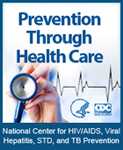National HIV Testing Day (June 27)
Statement
For immediate release: June 26, 2014
Contact: National Center for HIV/AIDS, Viral Hepatitis, STD, and TB Prevention
(404) 639-8895 | NCHHSTPMediaTeam@cdc.gov
CDC Recommends New HIV Testing Approach to Diagnose Infection Earlier
Statement by Dr. Jonathan Mermin
Director, National Center for HIV/AIDS, Viral Hepatitis, STD, and TB Prevention Centers for Disease Control and Prevention

Jonathan Mermin, MD, MPH
National HIV Testing Day offers an opportunity to reflect on the pivotal role that HIV testing plays in our nation’s ever-expanding prevention toolkit. Since National HIV Testing Day was first observed in 1995, we’ve seen tremendous advances in HIV prevention, ranging from daily pre-exposure prophylaxis (PrEP) to prevent HIV acquisition, to antiretroviral therapy for people living with HIV to prevent transmission.
HIV testing is the linchpin for prevention and treatment. For people who test HIV-positive, diagnosis opens the door to life-saving treatment, which also reduces the risk of transmitting HIV to others. For those who test negative, knowing their status empowers them to remain HIV-free.
However, more than half of American adults still have never been tested for HIV. Nearly 1 in 6 people living with HIV in the United States do not know they have HIV, meaning that they are missing out on essential care and may unknowingly transmit the virus. Roughly half of the estimated 50,000 new HIV infections each year are transmitted by people who don’t know that they are HIV-positive.
At the same time, the nation is making steady progress on HIV testing, just as we have in the development of new prevention options. Since CDC recommended HIV testing for all Americans aged 13-64 in 2006, the proportion of people who are unaware of their HIV infection has declined steadily, from approximately 20 percent to 16 percent. And just today, CDC issued important new guidance that could help the nation reduce that number further.
Today, CDC is recommending a new approach for HIV testing in laboratories that capitalizes on the latest technology to improve diagnosis of acute infection, the earliest stage of HIV infection when people are most likely to transmit the virus. Identifying acute infections has long been one of our nation’s biggest HIV prevention challenges, since these infections eluded traditional testing technologies. But with consistent and widespread use of this new testing method, we can diagnose people several weeks earlier than before. CDC is supporting laboratories to adopt this new approach as quickly as possible.
HIV testing is fast, easy and empowering. On National HIV Testing Day, I urge all Americans to take the test and take control of their health.
###
- Page last reviewed: June 26, 2014
- Page last updated: June 26, 2014
- Content source:


 ShareCompartir
ShareCompartir

